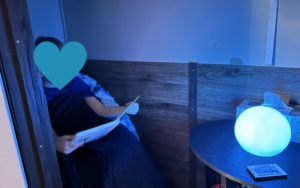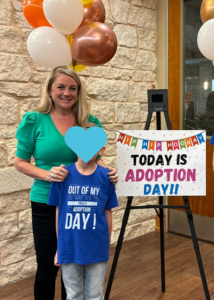Heart of CASA: April 2023
The Heart of CASA is a series to highlight the aspects of our volunteer work. Advocacy for a child in care covers several activities from court hearings to visits with a child to conversations with parents. Each month, we’ll share a story of a small (or big!) moment from one of our cases that exemplifies what advocacy can mean to a child and their families.
Experiencing Felt Safety
Trauma, such as abuse or neglect, can change a child’s brain development and brain chemistry, which can lead to a higher risk of emotional problems and behavioral issues. With brains operating in survival mode, children from hard places seek to get their needs met in any way possible. The good news is brains are plastic, meaning they can adapt to new situations. Healing is possible when a child develops a relationship with a loving caregiver. Trust-based Relational Intervention (TBRI®) teaches caregivers how to build connections, empower children, and correct challenging behaviors.
We need your help!
 On a Saturday, CASA Advocate Rachel* received an urgent call from the foster parents of William*, the child she advocates for. The foster parents said that the six-year-old boy had been upset and angry for almost two hours, yelling and throwing his toys. Their usual techniques for calming him when he was upset weren’t working. Since William liked and trusted Rachel, the foster parents asked if she could come to their house. Rachel drove to their home, unsure if she could help but she wanted to support William and his foster parents.
On a Saturday, CASA Advocate Rachel* received an urgent call from the foster parents of William*, the child she advocates for. The foster parents said that the six-year-old boy had been upset and angry for almost two hours, yelling and throwing his toys. Their usual techniques for calming him when he was upset weren’t working. Since William liked and trusted Rachel, the foster parents asked if she could come to their house. Rachel drove to their home, unsure if she could help but she wanted to support William and his foster parents.
Unstable background
Prior to William entering foster care a year and a half ago, he’d never experienced stability. At five years old, he’d lived with multiple family members in different homes and had never had a consistent caregiver. When the Department of Family Protective Services received an allegation of neglect and abuse, an investigator determined he was not safe in the home. When the Department was unable to find a relative who could care for him, William was placed in a foster home while his parents worked on a court-ordered service plan, agreed upon with DFPS.
First-time foster parents, Taylor* and Avery* knew that predictability would help William thrive in an unfamiliar environment. They set up routines for William at home and school, so that he knew what to expect from day to day. Like many kids in care, William needed help working through his emotions, and his foster parents found a therapist who began to work with him. William began to flourish, making great strides in school and building a bond with his foster parents.
William’s behavior in his foster home began to shift as he processed his emotions after his parents’ rights were terminated. His outbursts became more frequent and more intense. The foster parents worked with his therapist, his caseworker, and CASA to support William.
Connection leads to conversation
When Rachel arrived that evening, William had calmed down and was in his room. She walked in and sat down next to him on the floor. He crawled in her lap and laid his head on her shoulder. After comforting him, Rachel asked him, “Buddy, can you tell me what’s going on?”
William began to cry. He told Rachel of his fear that he would be moved again, and he wanted to stay with his foster parents. Though CPS, CASA, and the foster parents had explained to William that the foster parents were in the process of adopting him, he continued to be afraid that he would be removed from the home where he felt safe and loved. When he experienced this fear, he felt “out of control.” That led him to act out, which made him even more afraid that the foster parents would not want him to stay. The cycle kept repeating.
Rachel and William talked about some calming techniques when he felt scared, and he gave Rachel permission to share with his foster parents what he told her. On her way home, Rachel called her Case Supervisor, who is a TBRI® practitioner, and they discussed some TBRI strategies that might help the foster parents meet William’s need for safety and permanency.
Some of the strategies included the foster parents getting on William’s level when he was upset and practicing short scripts to use when William was upset, such as “I’m here” and “You’re safe.” Rachel also suggested they use healthy touch with permission, such as a hug, hand on his shoulder, or hand squeeze, when William was angry. They also agreed that having a “calming spot” in the house with fidgets, comfortable seating, a weighted blanket, and other soothing items might help William when he feels unable to control himself. Rachel called Taylor and Avery and discussed the ideas with them and referred them to CASA for TBRI coaching.

Hope and healing
The next day Rachel received a text with a photo of William reading in his new “calming corner.” That morning William and his foster parents transformed an unused space into an area where he could go when he felt overwhelmed. Along with fidgets, books, and a beanbag chair, they added a fun lamp.
At a recent visit, the foster parents told Rachel that William was doing well. The outbursts had become less frequent. At the TBRI coaching sessions at CASA, they learned ways to help connect with and empower William. They also learned how they can use engagement strategies, such as behavioral matching, voice quality, and nurturing touch, to help William feel safe when he was dysregulated.
With his foster parents helping him learn to meet his needs in healthier ways, William was given voice. The return of his voice brought hope and healing for his future.**
*Names changed for privacy
 **In November 2023, William’s future continued to unfold. He celebrated his adoption by his foster parents alongside his Advocate, Caseworker, CASA staff, and several family members, including a cousin. When Rachel walked into the ceremony, William jumped up, ran to her, and hugged her, his smile reaching from ear to ear. He proudly showed her his shirt that read “Out of my way. It’s finally adoption day!”
**In November 2023, William’s future continued to unfold. He celebrated his adoption by his foster parents alongside his Advocate, Caseworker, CASA staff, and several family members, including a cousin. When Rachel walked into the ceremony, William jumped up, ran to her, and hugged her, his smile reaching from ear to ear. He proudly showed her his shirt that read “Out of my way. It’s finally adoption day!”
EVERY CHILD DESERVES A CHANCE … IT’S YOU!
Learn more about becoming a CASA volunteer: VOLUNTEER or give online DONATE
